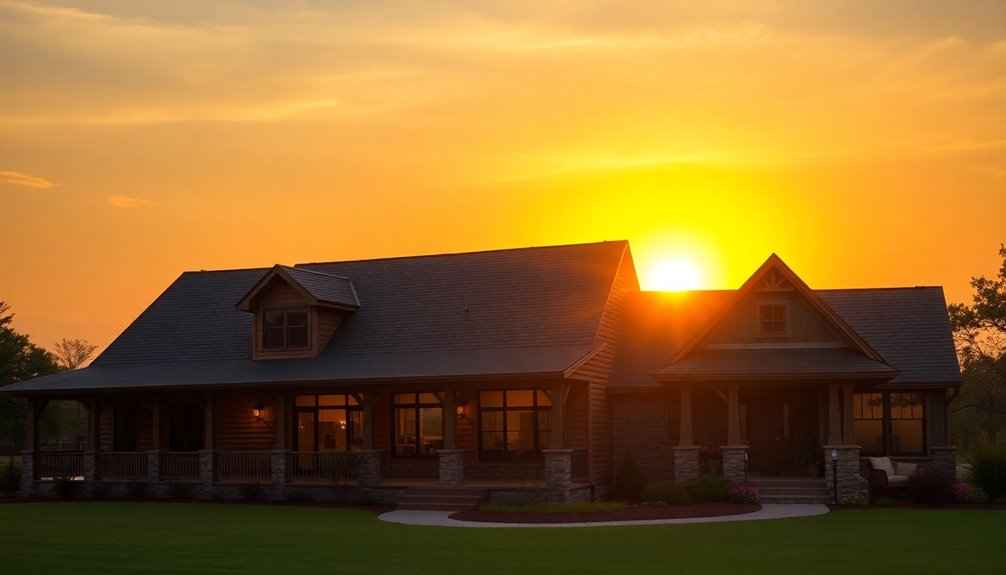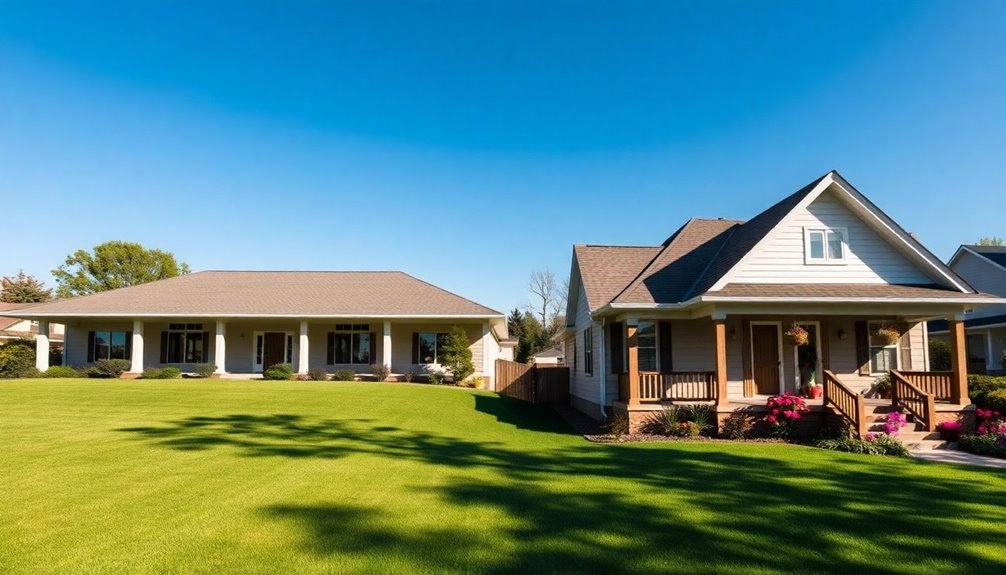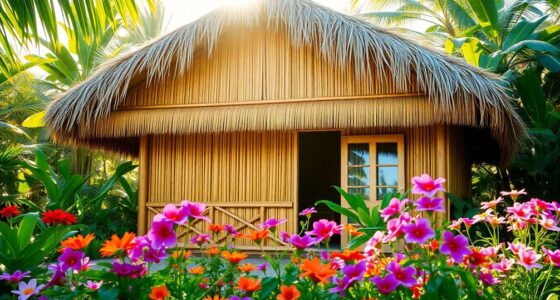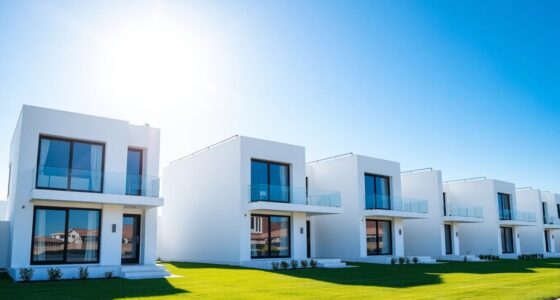A ranch house and a bungalow differ mainly in size, layout, and design. You'll find ranch homes are typically single-story with open floor plans, designed for spacious living and family gatherings. Bungalows, on the other hand, usually feature 1.5 stories and compartmentalized spaces, offering a cozy, traditional charm. While ranches thrive in suburban areas, bungalows appeal more to urban dwellers due to their efficient use of smaller spaces. If you're curious about which style might fit your lifestyle better, stick around to explore more details about each home type and what they offer.
Key Takeaways
- Ranch houses are typically single-story with open floor plans, while bungalows often have a 1.5-story design with compartmentalized spaces.
- Ranch homes feature low-pitched roofs and large windows, whereas bungalows are characterized by small verandas and overhanging eaves for charm.
- Bungalows are generally smaller and suited for urban settings, while ranch homes require more land and thrive in suburban areas.
- Ranches emphasize spaciousness and flexible design, while bungalows focus on efficient use of smaller spaces and functionality.
- Property values for bungalows can be higher due to desirable locations, while ranch homes often have lower property taxes.
Historical Context

Although both ranch houses and bungalows emerged during pivotal moments in American history, they reflect different social and economic contexts.
Ranch homes gained traction in the 1920s and exploded in popularity during the post-World War II housing boom, representing suburban expansion. By the 1950s, they accounted for 90% of American homes, embodying the dream of home ownership for many families.
In contrast, bungalows were primarily built between 1910 and 1930, particularly in Chicago, where they formed one-third of the city's single-family home stock.
These architectural styles illustrate the shift from urban expansion in the early 20th century to the growing desire for space and community in the suburbs, marking significant changes in American housing trends.
Architectural Features

The architectural features of ranch houses and bungalows reflect their distinct historical contexts and design philosophies.
A ranch house typically boasts a single-story layout with an open floor plan, emphasizing flow between main living areas. You'll notice low-pitched roofs and large windows that create an airy atmosphere, ideal for modern lifestyles.
In contrast, bungalows often showcase a 1.5-story design, featuring more compartmentalized spaces. Their unique architectural features include small verandas and overhanging eaves, offering a cozy charm.
Bungalows usually incorporate brick materials, providing a sturdy appearance, while ranch houses focus on practicality and spaciousness.
These differences highlight how each style caters to varying preferences in functionality and aesthetics.
Size and Layout

When comparing ranch houses and bungalows, size and layout play an essential role in defining their character.
Ranch homes typically offer larger square footage and a single-story layout, featuring wide, interconnected living spaces that promote an open-concept design. This spaciousness allows for multiple bedrooms and living areas, giving you more room to spread out.
In contrast, bungalows are generally smaller and often have a 1.5-story design, focusing on maximizing functionality within a compact footprint. Their cozy atmosphere often includes separate rooms and potential attic conversions for extra bedrooms.
While ranch homes thrive on extensive land use, bungalows suit urban settings better, requiring less land and adapting well to higher property taxes.
Design Flexibility

When it comes to design flexibility, ranch homes and bungalows offer unique customization options.
You can create spacious, open layouts in ranch houses, while bungalows focus on efficient use of smaller spaces.
Each style has its own strategies for utilizing space that reflect your personal aesthetic and lifestyle needs.
Customization Options
Customization options in ranch and bungalow homes offer you unique ways to shape your living space.
Ranch houses provide diverse design choices, allowing you to choose from various floor plans that reflect your lifestyle. You can create an open floor plan that combines spaciousness with coziness, tailoring the layout to fit your needs.
On the other hand, bungalows emphasize maximizing functionality in smaller areas, often featuring customizations like attic conversions for extra bedrooms. With bungalows, you can incorporate distinct architectural details and finishes that showcase your personal style.
Both styles reflect changing architectural trends, with ranch homes maintaining a modern essence while bungalows offer a charming, traditional aesthetic that invites creative customization.
Space Utilization Strategies
While ranch-style homes excel in creating an airy, open environment that encourages interaction, bungalows focus on clever space utilization to maximize functionality in their cozier layouts.
In ranch designs, you'll find flowing open spaces that connect the living room, dining area, and kitchen, making social gatherings seamless. This design flexibility accommodates diverse lifestyles, allowing for various configurations.
Conversely, bungalows prioritize efficient use of every inch. You might see built-in shelving and attic conversions that enhance usable square footage.
Separate dining rooms and distinct kitchen areas cater to a more compartmentalized living experience, demonstrating how bungalows cleverly adapt to smaller spaces while ensuring that functionality remains at the forefront of home building.
Location and Market Trends

As you explore the differences between ranch houses and bungalows, you'll notice that their locations heavily influence market trends.
Ranch-style homes typically thrive in suburban markets, appealing to families who prioritize larger living spaces and the serene environment of rural areas. In contrast, bungalows are often nestled in urban centers, attracting buyers drawn to their charm and affordability despite smaller plots.
While property values for bungalows can be higher due to their desirable locations, ranch homes often come with lower property taxes.
The market trends show a consistent interest in both styles: ranch homes remain popular for spacious layouts, whereas bungalows continue to attract those seeking functionality and character in bustling city environments.
Cultural Impact

The differences in location and market trends between ranch houses and bungalows also reflect their cultural impact on American society. Both architectural styles symbolize the American Dream, representing middle-class aspirations during their prime construction eras. Bungalows, particularly the Chicago style, flourished in urban areas, while ranch homes dominated the suburban landscape post-World War II.
| Feature | Bungalow | Ranch |
|---|---|---|
| Location | Urban areas | Suburban living |
| Construction Era | 1910 – 1930 | Post-World War II |
| Appeal | Charm and affordability | Spaciousness |
| Cultural Impact | One-third of Chicago homes | 90% of homes in the '50s |
| Preservation | Influences modern practices | Continues to attract families |
These styles endure, highlighting evolving lifestyle needs.
Frequently Asked Questions
Is a Bungalow the Same as a Ranch House?
No, a bungalow isn't the same as a ranch house.
While both are popular home styles, they differ in layout and design. You'll find bungalows typically have a 1.5-story structure with distinct rooms, promoting coziness.
In contrast, ranch houses are single-story with open floor plans, encouraging interconnected living.
If you're considering which style suits you better, think about your space needs and preferred living environment. Each has its unique charm!
What Makes a House Considered a Bungalow?
When you think of a cozy retreat, a bungalow often comes to mind.
It's a single-story home that embraces efficiency and charm. You'll notice low-pitched roofs and wide eaves that invite relaxation.
The layout usually features distinct spaces, like a welcoming entryway leading to a parlor or dining area.
Built mainly in the early 20th century, bungalows reflect a blend of practicality and craftsmanship, making them a cherished choice for many families.
What Makes a House a Ranch House?
A ranch house stands out with its long, low profile and open floor plan.
You'll notice its single-story design, which promotes easy accessibility.
Look for features like low-pitched rooflines, wide eaves, and large windows that blend indoor and outdoor spaces.
Often, ranch homes have attached garages or carports, emphasizing functionality and spaciousness.
Variations include split-level and rustic styles, adapting to different preferences while maintaining that signature ranch aesthetic.
What Do You Call a Ranch House With a Basement?
If you've got a ranch house with a basement, you're looking at what's commonly called a raised ranch.
This style elevates the main living area above ground level, often featuring larger basement windows and extra living space.
You'll find a split-level design, with the main floor accessible by a short flight of stairs.
It's a great option if you need more room, blending the convenience of a single-story layout with the benefits of a basement.
Conclusion
To sum up, while both ranch houses and bungalows offer unique charm and functionality, their differences in style and layout cater to various needs. For instance, if you're seeking a spacious open floor plan for family gatherings, a ranch house like the one in the suburb of Maplewood might be ideal. On the other hand, if you prefer a cozy, intimate setting, a bungalow such as the charming cottage in Oakville could be perfect for you.









